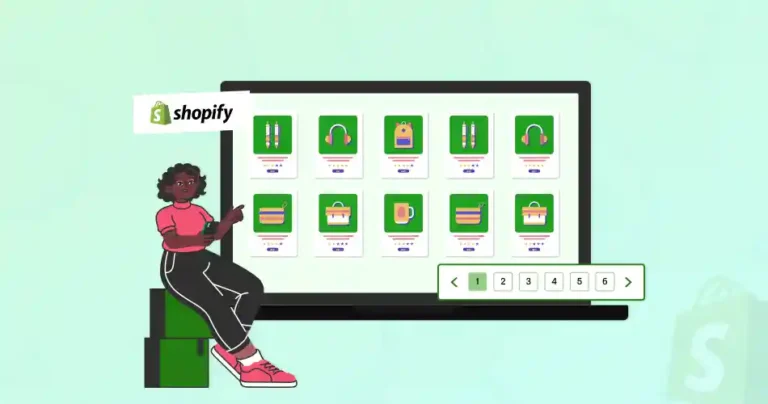In the past few years, especially after the Covid, the eCommerce growth has exploded, with online sales surpassing $6.3 Trillion in 2024. With this growth, the catalogs have expanded, meaning a need for more efficient management and display of the product data. That’s where Shopify GraphQL pagination comes in.
With this GraphQL pagination, Shopify eStores can fetch and display data in manageable chunks without compromising speed or user experience. But for that, you need a clear understanding of its mechanics, from cursor-based navigation to optimizing query performance.
That’s what we will discuss through this. we’ll explain how the Shopify experts implement GraphQL pagination and improve the store performance effectively. Let’s begin.
GraphQL pagination is a technique used to manage and retrieve large datasets in smaller, more manageable chunks, or “pages,” rather than fetching all the data at once. This tactic is particularly useful in applications like eCommerce, where you need to display thousands of products or orders in a single request would be inefficient and slow.
Key features include:
- Cursor-Based Navigation: Enables precise tracking of records, ideal for dynamic datasets.
- Customizable Queries: Allows developers to specify the exact number of items per page.
- Efficient Data Fetching: Reduces load times by fetching only the required data.
- Forward and Backward Navigation: Supports bidirectional pagination for seamless user experiences.
You can leverage these features to efficiently handle large datasets while maintaining fast, responsive storefronts.
Types of Pagination
Pagination methods are typically categorized into offset-based and cursor-based approaches:
- Offset-Based Pagination: Retrieves data by skipping a specified number of records. While simple to implement, it can be slow for large datasets and prone to issues with changing data.
- Cursor-Based Pagination: Uses unique identifiers (cursors) to fetch the next or previous set of records. This method is faster, more reliable, and handles dynamic data changes better, making it the preferred choice for Shopify’s GraphQL API.
Mastering GraphQL and pagination fundamentals empowers developers to build scalable, high-performing Shopify stores. Understanding these tools sets the foundation for efficient data handling and enhanced user experiences.
Shopify uses the Relay-style cursor-based pagination in its GraphQL API. This method provides a pageInfo object containing metadata (e.g., hasNextPage, hasPreviousPage) and cursors (e.g., startCursor, endCursor) to navigate through pages. Here’s how it goes.
Step 1: Set Up the React Project
First, create a new React project using Create React App.
npx create-react-app shopify-graphql-pagination
cd shopify-graphql-pagination
Step 2: Install Apollo Client
Install the necessary dependencies for Apollo Client.
npm install @apollo/client graphql
Step 3: Create a Storefront Access Token
- Log in to Your Shopify Admin: Go to your Shopify store’s admin panel.
- Navigate to Apps: In the admin panel, click on “Apps” in the left-hand menu.
- Manage Private Apps: Scroll down and click on “Manage private apps” at the bottom of the page.
- Create a New Private App: Click on the “Create a new private app” button.
- Configure the App:
- Name: Give your app a name.
- Storefront API: Ensure that the “Storefront API” section is enabled.
- Permissions: Grant the necessary permissions. For accessing products, you need “Read access” for “Products”.
- Save the App: Click the “Save” button.
- Copy the Access Token: In the “Storefront API” section, you will see the “Storefront access token”. Copy this token and keep it secure.
Step 4: Setup Apollo Client
Create a new file src/apolloClient.js to configure Apollo Client.
// src/apolloClient.js
import { ApolloClient, InMemoryCache, createHttpLink } from '@apollo/client';
import { setContext } from '@apollo/client/link/context';
const shop = 'your-shop-name.myshopify.com';
const accessToken = 'your-storefront-access-token'; // Replace with your Storefront access token
const httpLink = createHttpLink({
uri: `https://${shop}/api/2023-10/graphql.json`, // Storefront API endpoint
});
const authLink = setContext((_, { headers }) => {
return {
headers: {
...headers,
'X-Shopify-Storefront-Access-Token': accessToken,
},
};
});
const client = new ApolloClient({
link: authLink.concat(httpLink),
cache: new InMemoryCache(),
});
export default client;
Step 5: Create GraphQL Queries
Create a new file src/queries.js to define your GraphQL queries.
// src/queries.js
import { gql } from '@apollo/client';
export const GET_PRODUCTS = gql`
query GetProducts($first: Int, $after: String) {
products(first: $first, after: $after) {
edges {
node {
id
title
handle
description
images(first: 1) {
edges {
node {
url
}
}
}
}
cursor
}
pageInfo {
hasNextPage
endCursor
}
}
}
`;
Step 6: Create the Main Component
Create a new file src/App.js to define your main component.
// src/App.js
import React from 'react';
import { ApolloProvider, useQuery } from '@apollo/client';
import client from './apolloClient';
import { GET_PRODUCTS } from './queries';
const Products = () => {
const { loading, error, data, fetchMore } = useQuery(GET_PRODUCTS, {
variables: { first: 10 },
});
if (loading) return <p>Loading...</p>;
if (error) return <p>Error :(</p>;
const loadMore = () => {
fetchMore({
variables: {
after: data.products.pageInfo.endCursor,
},
updateQuery: (prev, { fetchMoreResult }) => {
if (!fetchMoreResult) return prev;
return {
products: {
__typename: prev.products.__typename,
edges: [...prev.products.edges, ...fetchMoreResult.products.edges],
pageInfo: fetchMoreResult.products.pageInfo,
},
};
},
});
};
return (
<div>
{data.products.edges.map(({ node }) => (
<div key={node.id} style={{ marginBottom: '20px' }}>
<h2>{node.title}</h2>
{node.images.edges[0] && <img src={node.images.edges[0].node.url} alt={node.title} style={{ width: '100px' }} />}
<p>{node.description}</p>
</div>
))}
<button onClick={loadMore} disabled={!data.products.pageInfo.hasNextPage}>
Load More
</button>
</div>
);
};
const App = () => (
<ApolloProvider client={client}>
<Products />
</ApolloProvider>
);
export default App;
Step 7: Update index.js
Update src/index.js to render the App component.
// src/index.js
import React from 'react';
import ReactDOM from 'react-dom';
import './index.css';
import App from './App';
ReactDOM.render(
<React.StrictMode>
<App />
</React.StrictMode>,
document.getElementById('root')
);
Step 8: Run the Application
Start the development server.
This setup ensures efficient data handling and a seamless user experience. You can further customize and extend this application based on your specific requirements.
If you need help with implementing this process effectively, have a consultation with our professional Shopify development company.
These strategies ensure optimal performance, efficient data handling, and seamless scalability for large Shopify stores.
Optimizing Pagination Queries
To maximize performance, always select only the fields you need in your GraphQL queries. Unnecessary fields increase payload size and slow down responses.
Combine pagination with filters to narrow down results, such as fetching products by specific tags, collections, or availability.
For example, instead of retrieving all product details, query only the id, title, and price fields for a product list page. This ensures faster response times and reduced data transfer.
Handling Edge Cases
Pagination queries may encounter edge cases, such as empty datasets or API errors. Handle these gracefully by checking if the edges array is empty before processing the data.
For instance, in a React app, you can show a “No results found” message when no data is returned.
Additionally, implement robust error handling using try-catch blocks to capture and log API errors, ensuring the app doesn’t crash during unexpected failures.
Caching Strategies
Caching can significantly boost performance by reducing repetitive API calls. Store frequently accessed pages or query results locally or in a server-side cache.
Use tools like React Query or Apollo Client to implement caching in frontend applications. Ensure that cached data is invalidated or refreshed when new changes are made to the store to maintain accuracy.
Rate Limiting Considerations
Shopify enforces rate limits to prevent excessive API usage, calculated using a cost-based system where each query has a cost value.
Always monitor the X-Shopify-Shop-Api-Call-Limit header in the response to ensure you stay within the limits. To handle rate limits effectively:
- Use efficient queries with lower cost values.
- Implement a retry mechanism with a delay for requests exceeding the limit.
- Distribute API requests over time to prevent spikes in usage.
Implementing advanced pagination techniques not only improves data efficiency but also contributes to a smoother, more reliable shopping experience.
By refining your approach with these best practices, you can ensure your Shopify store remains scalable, responsive, and ready to meet evolving customer needs. For that, you can hire dedicated Shopify experts from our team and make sure of the best results through these practices.
Let’s Conclude
Efficient data handling is paramount for any successful eCommerce operation. Shopify’s GraphQL Admin API, coupled with its robust pagination capabilities, helps optimize data fetching and create seamless shopping experiences.
Implementing the techniques outlined in this blog will not only improve the speed and responsiveness of your applications but also enhance the overall UX. That means better customer satisfaction and potentially higher conversion rates.
If you need help implementing the Shopify GraphQL pagination on your store, connect with us today!
FAQs on Shopify GraphQL Pagination
Q1. Why use GraphQL pagination instead of REST?
GraphQL offers more control over the data you retrieve. With REST, you often get more data than you need, impacting performance. GraphQL pagination allows you to fetch only the specific product information you require for the current page, minimizing data transfer and improving efficiency. It also reduces the number of API requests needed for navigation.
Q2. Can I fetch all data at once instead of using pagination?
No, Shopify imposes limits on the number of records you can retrieve in a single API request. Pagination ensures that data is retrieved in smaller chunks, adhering to Shopify’s API rate limits.
Q3. What is the maximum number of items I can fetch per request in Shopify GraphQL?
The maximum limit for most queries is 250 items per request when using the first or last arguments. To retrieve more data, you must use cursors to paginate through the remaining results.





